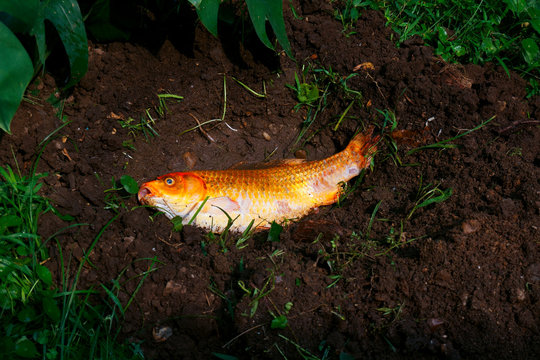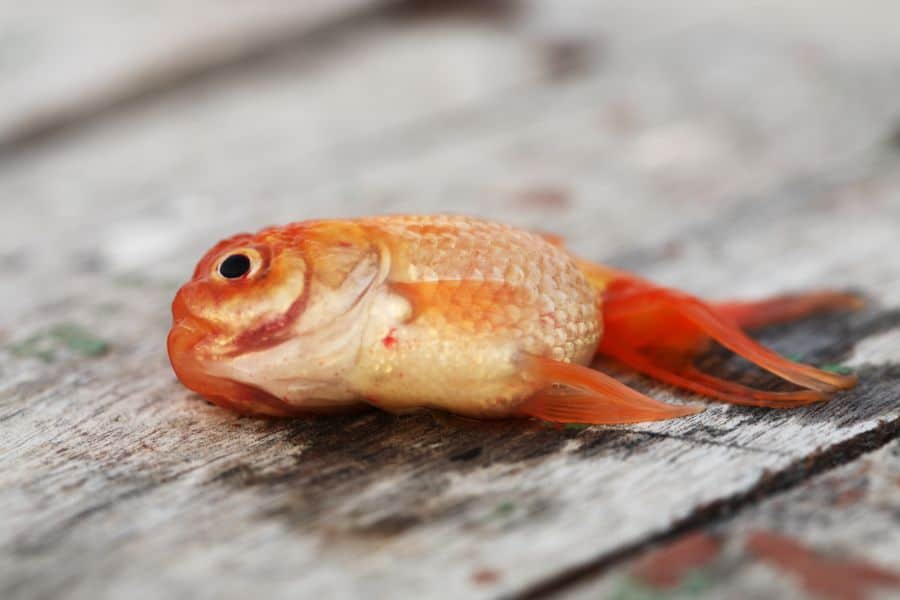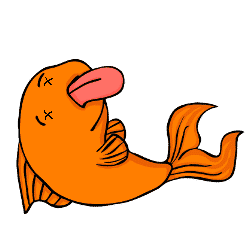“Why do goldfish die?” It’s an important question to ask because learning why goldfish die can help us understand how to keep them alive.
With proper care, goldfish have the potential to live a very long time.
In the vast majority of cases, there really is no excuse for a goldfish dying within weeks or months.
Our own research has shown that 80% of our readers have kept their goldfish alive for over a year – and some for much longer – but 1 in 5 goldfish keepers have never kept a fish alive beyond one year.
If your goldfish is dying – or perhaps your fish already died and you want to stop it from happening again – you’ve come to the right place.
Read on to find out why goldfish die and what you can do to keep your goldfish alive.
Key Takeaways:
- Causes of Goldfish Death: Goldfish die due to factors such as poor water quality, improper tank size, overfeeding, disease, and stress from fighting with other fish.
- Signs of Illness: Symptoms like white or black marks, gasping for air, red marks, or raised scales can indicate poisoning, diseases, or improper environmental conditions.
- Proper Tank Maintenance: Ensure a clean tank with balanced water parameters (ammonia, nitrites, oxygen levels) to keep goldfish healthy.
- Overfeeding Risks: Goldfish should not be overfed as it can lead to constipation, poor water quality, and illness.
- Disposing of a Dead Goldfish: Never flush dead goldfish. Options include burying, cremation, or discarding them in the trash (double-bagged to prevent odor).
- Prevention: Regular tank maintenance, proper feeding, and avoiding stress can greatly improve your goldfish’s lifespan.
Why did my goldfish die?
Lots of people get in touch with us and ask “Why are my goldfish dying?”.
Sadly, it’s a really difficult question to answer without knowing a lot about the fish, its tank, its tank mates, and the symptoms it showed before it died.
There are lots of reasons why a goldfish might die. These include:
- Unsuitable living conditions: For example, keeping your fish in a tank that is too small, or not using a filter.
- Poor water quality: There are lots of water parameters that you need to balance to keep your goldfish healthy.
- Overfeeding: Goldfish really don’t need to eat much, and over-feeding can be very bad for them.
- Fighting with other fish: This can cause injuries and stress, which ultimately leads to illness and death.
- Accidents or injuries: For example, jumping out of the tank or getting stuck on the filter or in a decoration.
- Diseases: There are lots of infections and illnesses that can lead to the death of your fish.
- Old age: Of course, every fish dies eventually! If you’ve had your fish a very long time, it could simply have died of natural causes. However, bear in mind that goldfish have a very long lifespan.
If one of your goldfish dies, it’s important to work out why.
Understanding why your goldfish died will help you to keep your other fish alive, as well as any goldfish you may buy in the future.
But how do you identify the cause of your goldfish’s death?
My goldfish died… but I don’t know why!
Let’s look at some reasons why goldfish die, and the symptoms that allow you to work out the cause of death.
My goldfish died… and it has white or black marks on its fins and gills. Its fins look “clamped” together.
This sounds like a classic case of ammonia poisoning.
In particular, your goldfish turning black is a common sign of ammonia burns that are in the process of healing.
Ammonia is a toxic chemical that builds up in your tank if it is too small or not properly cycled.
To avoid this in the future, make sure to buy a big enough tank for your goldfish and that it is fully cycled (zero ammonia, zero nitrites, and less than 40 ppm nitrates) before adding your fish.
My goldfish died… while near the top of the tank, looking like it was gasping for air. Its gills would move a lot.
This sounds like your goldfish suffered from a lack of oxygen and died because it was struggling to breathe. Make sure your Ph and KH aren’t too low and that there is movement in your water. This movement could come from your filter or from an air pump.
My goldfish died… and it had red lines on its tail and red marks on its body.
These red marks are a sign of nitrite poisoning. Like ammonia, nitrite is toxic to fish, and there shouldn’t be any in a properly cycled tank. You should therefore check that your tank is properly cycled to ensure this doesn’t happen again.
My goldfish died… and it had a big string of poop behind it a lot of the time.
Seeing your goldfish with a big trail of poop behind it is a sure sign of constipation. If your goldfish died after displaying this symptom, it was almost certainly because you gave it too much food.
My goldfish died… and it had raised scales, didn’t eat much, and didn’t move much.
All of these symptoms are a sign that your water temperature was too high. Get a thermometer and check that your tank is in the correct temperature range for goldfish.
My goldfish died… after sitting at the bottom of the tank not moving or eating.
This could be a sign of shock. Did you change a lot of your goldfish’s water at once?
You should perform small, regular water changes, rather than big water changes. Sudden changes in water parameters can shock your goldfish, and potentially even kill them.
My goldfish died… and it had fungus on its body, frayed fins, and/or light or dark-colored poop.
These symptoms could all be signs of an infection. You should therefore clean out your tank (assuming you have no other fish – if you do, watch your other fish closely to see if they show the same symptoms), cycle it again, and quarantine any new fish before adding them to your main tank.
My goldfish died… after being chased around the tank by its tank mates.
While this might look like playing, and is sometimes a sign of mating, it can be very stressful for the fish being chased. Goldfish don’t respond well to stress. It lowers their immune system, which can make them ill and potentially lead to them dying.
You should make sure that your goldfish is living with suitable tank mates. And, if not, be ready to separate your fish into separate tanks.
My goldfish died… and showed other symptoms not listed above.
It might be that your fish had some other illness or disease. We recommend reading through our articles on goldfish diseases to see if any of them match your fish’s symptoms.
How to dispose of dead goldfish
If your goldfish died, you might be wondering how to dispose of dead fish. Whatever you do – please do NOT flush them down the toilet.
Flushing dead fish down the toilet can pollute the water in your area and risk spreading diseases to wild fish. This is not a responsible way to dispose of your dead goldfish, so please don’t do it.
The very first thing you will want to do is verify the fish is dead. Some fish can float upside down or in different areas of the tank due to health problems, such as constipation.
Removing a dead goldfish
Watching for movement and breathing for a few moments should determine if the fish has passed on. The eyes will go grey once deceased.
After ensuring the fish is dead it needs to be removed as soon as possible. You can use a net, or your hands if you’re comfortable with that, and then place it in a paper bag or double bagged in a Ziploc baggie. A paper bag merely hides what’s in the bag better, which can make it easier to dispose of. A paper bag will also decompose with your fish if you bury it.
No matter how it is removed, whatever was used needs to be sterilized in case the fish dies from an illness. It is possible that if the fish is left in the tank too long then the other fish in the aquarium will eat the dead fish. If you are unsure of where and how you are burying your fish, then it is recommended to place it in the freezer to preserve it for some time while you decide. If placed in the freezer then you will need to place it in a bucket or bowl, so any water doesn’t leak out of the bag and cause a frozen mess.
There are three options for what to do with your dead goldfish; burial, throwing away, or cremation.
Burying a goldfish

If you decide to bury your fish, then it will need to be buried in a hole that is at least three feet deep. This depth will deter local wildlife, local cats, and local dogs from wanting to unbury the fish.
We recommend that you place a heavy stone on top of the burial location to further help deter digging from other animals.
Many people will bury their beloved fish near a tree, bush, or plant because their bodies will become natural fertilizer for the plant. The plant, tree, or bush also doubles as a grave marker. The fish can be buried in a decomposable bag or placed directly in the ground.
Throwing away a goldfish
Instead of flushing your goldfish, you should seal it in a bag and put it in the bin. It’s important to use a bag, as otherwise flies will lay eggs, which will hatch into maggots. You might get a bad smell too!
If you decide to dispose of your fish in the trash, then we suggest that the fish is double bagged in a Ziploc to prevent a smell from attracting wildlife into the trash. They can also be placed in a small cardboard box.
Keep in mind the length of time from disposal to when the trash is picked up. If it is a long time, then the Ziploc bag will be best to prevent a smell from occurring.
Cremation
Cremation can be done at home if you are willing and determined enough. However, you should first verify your local laws to ensure it is ok to have a fire.
This method does have a few steps and does take some time to complete.
Step one: Place the fish on a piece of aluminum foil and on a cookie sheet. Put them in the oven at 200-250 degrees for 15 minutes. This step is to ensure that the fish is thoroughly dried out.
Step two: Once dry, allow it to cool on a plate for a few hours.
Step three: Build a fire and make sure the fire and embers are hot. Place the fish in an old pot and put the pot in the embers. After some time, you may need to gently press the fish down to create more ash and less char.
Step four: The cremation is complete when the fish is completely ash. You can then remove it from the fire and allow it to cool completely. The ash can be placed in jewelry or stored in a fish urn.
Can you flush a dead goldfish?
In the US, it is illegal to flush a fish, alive or dead, down the drain. Not all drains lead to a septic plant and those that don’t, can lead to a natural waterway such as oceans or rivers. If the fish died of an illness then you are exposing the local wildlife to the illness.
Wild fish are not as resistant to many diseases that commonly affect aquarium fish. Diseases such as ich or parasites can quickly make their way from the deceased fish to wild fish and decimate a whole population.
You should never release a live fish for the same reasons. If you find that you do not want your pet fish anymore then you need to rehome it. Asking local pet stores or posting up for sale is the best way to achieve this.
What to do when a fish has died

The first thing to do is remove the fish once you have verified it is dead.
Following the removal, the tank should have a big water change. This will remove any ammonia from the fish while it is starting to decompose.
Many people will also do a filter cleaning, gravel vacuuming, and addition of a probiotic bacteria supplement to keep the bacteria healthy after all the cleaning. This large cleaning will ensure that no bacteria or illness is left over from the deceased fish that could infect the rest of the tank.
Choose the right option for you
No matter which path you choose to dispose of your deceased pet, loss is hard. You should do whatever path that would bring you the most remembrance and joy for your pet. This can be done by burying, placing in the trash, or cremation.
If you are burying, make sure it’s three feet deep. If it’s trash, then make sure it is double-bagged to contain the smell. And if you are choosing a home creation, verify local laws. You should never flush your dead goldfish. Following the removal of your deceased fish, you should do a big water change to keep your tank healthy.
How to keep goldfish alive
The best way to keep your goldfish alive is to do your research, learn a lot about goldfish, and make sure you’re at least doing the basics of proper goldfish care. Of course, The Goldfish Tank is here to help!
We recommend reading our article on mistakes that goldfish keepers make, as many of these can lead to the death of your fish.
FAQs
- What would cause goldfish to die?
Goldfish can succumb to various factors that include poor water quality, inadequate nutrition, diseases, overcrowded tanks, or exposure to toxins. It’s crucial to maintain a clean and well-balanced environment, provide proper nutrition, and monitor their health regularly to prevent potential causes of death. - What to do when a goldfish dies?
When a goldfish dies, it’s essential to remove the deceased fish promptly to prevent any negative impact on water quality. Additionally, it’s crucial to assess the conditions in the tank, check for signs of illness in other fish, and take corrective measures to address any underlying issues that may have contributed to the death. - How do you keep goldfish alive?
To keep goldfish alive and thriving, follow these key tips:- Maintain good water quality by regularly testing and monitoring parameters.
- Provide a suitable tank size with proper filtration and aeration.
- Feed a balanced and varied diet appropriate for goldfish.
- Keep an eye on their health, watching for signs of illness or distress.
- Avoid overfeeding and ensure a clean living environment.
- Do goldfish die quickly?
The lifespan of a goldfish can vary based on factors such as care, genetics, and living conditions. With proper care, goldfish can live for many years, even surpassing a decade. However, if they are subjected to poor water quality, improper nutrition, or stressful environments, their lifespan may be significantly shortened, and they might exhibit signs of distress or illness.
Finally – learn from your mistakes!
We all get things wrong sometimes and very few people keep their very first goldfish alive for years. The important thing is that you learn for the future.

I have had fish for years without any problems atall even putting no tap safe or anything in the water! Now i live in an old house which uses water from a well. Got a bio orb tank last xmas and used the tap water and the tapsafe. Then the tap water was cloudy and sometimes dirty so we use bottled water and the tapsafe. Still my fish are dying. I lost one last week then the last one this morning. Dont know what to do anymore. Any help or ideas?
Hi Debbie – is your tank cycled? And by that, we mean have you gone through the process of building up bacteria in your tank to convert ammonia and nitrite to nitrate? Do you use test kits to monitor this? It’s not really about using tap or bottled water – while we might think of bottled water as more pure, that’s not what counts for your fish. In an uncycled tank, ammonia will build up in bottled water just as easily as in tap water. We also advise against BiOrbs. They’re usually too small – particularly for goldfish – and their shape means you don’t get as much surface area as a normal tank, this lead to less oxygen in the water. Hopefully that’s a start, but please reply if you’d like to discuss further!
Well let the waster sit there for 5-7 minets so the foggy particles could go. Some places there will be some things like that. Same with me.
My goldfish died. Yesterday night my gold fish was running around in the pool and bumped his head a few times on the floor of the pool. And in the morning the found out he is dead. Also his poop was hanging out every time he poops.